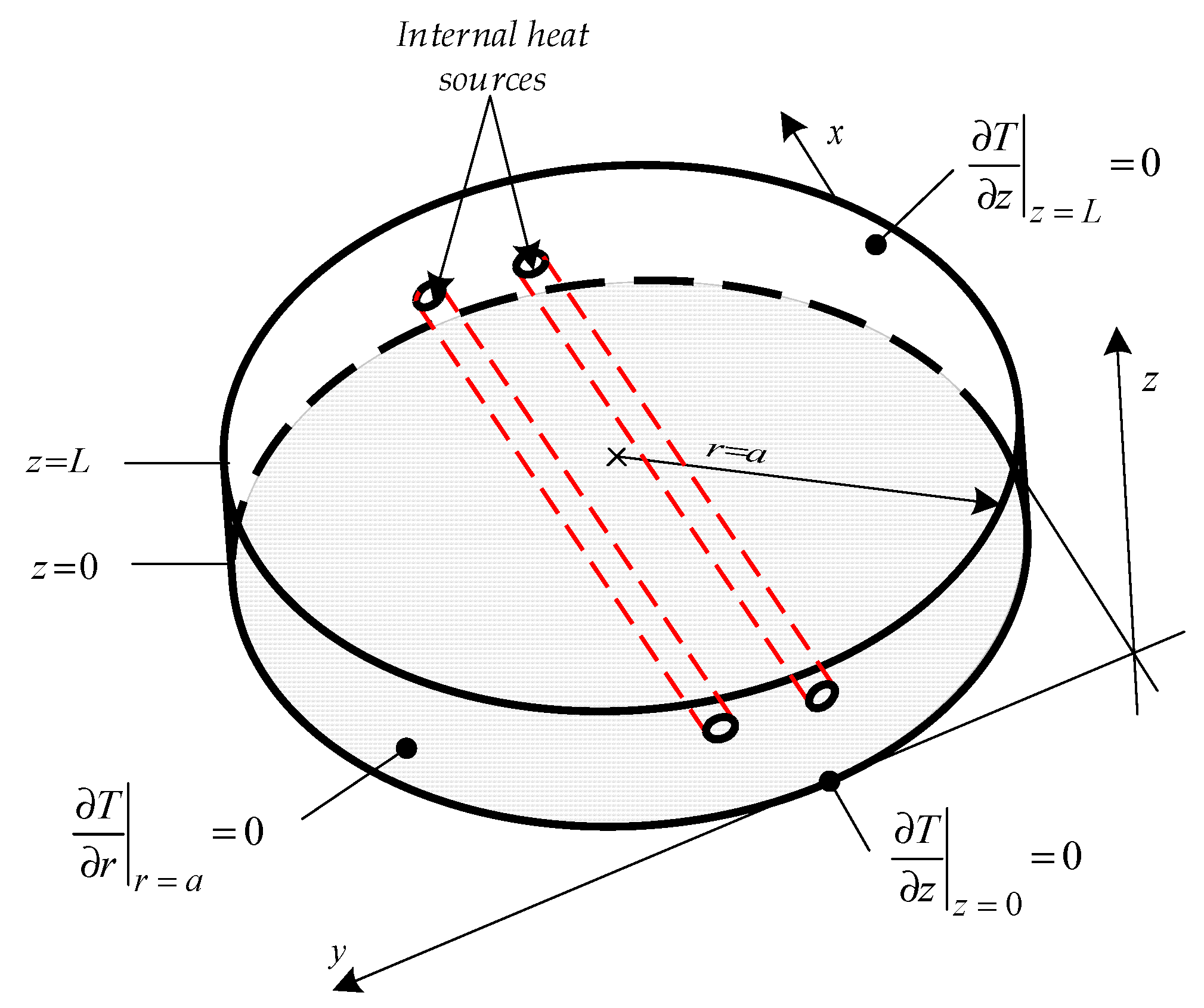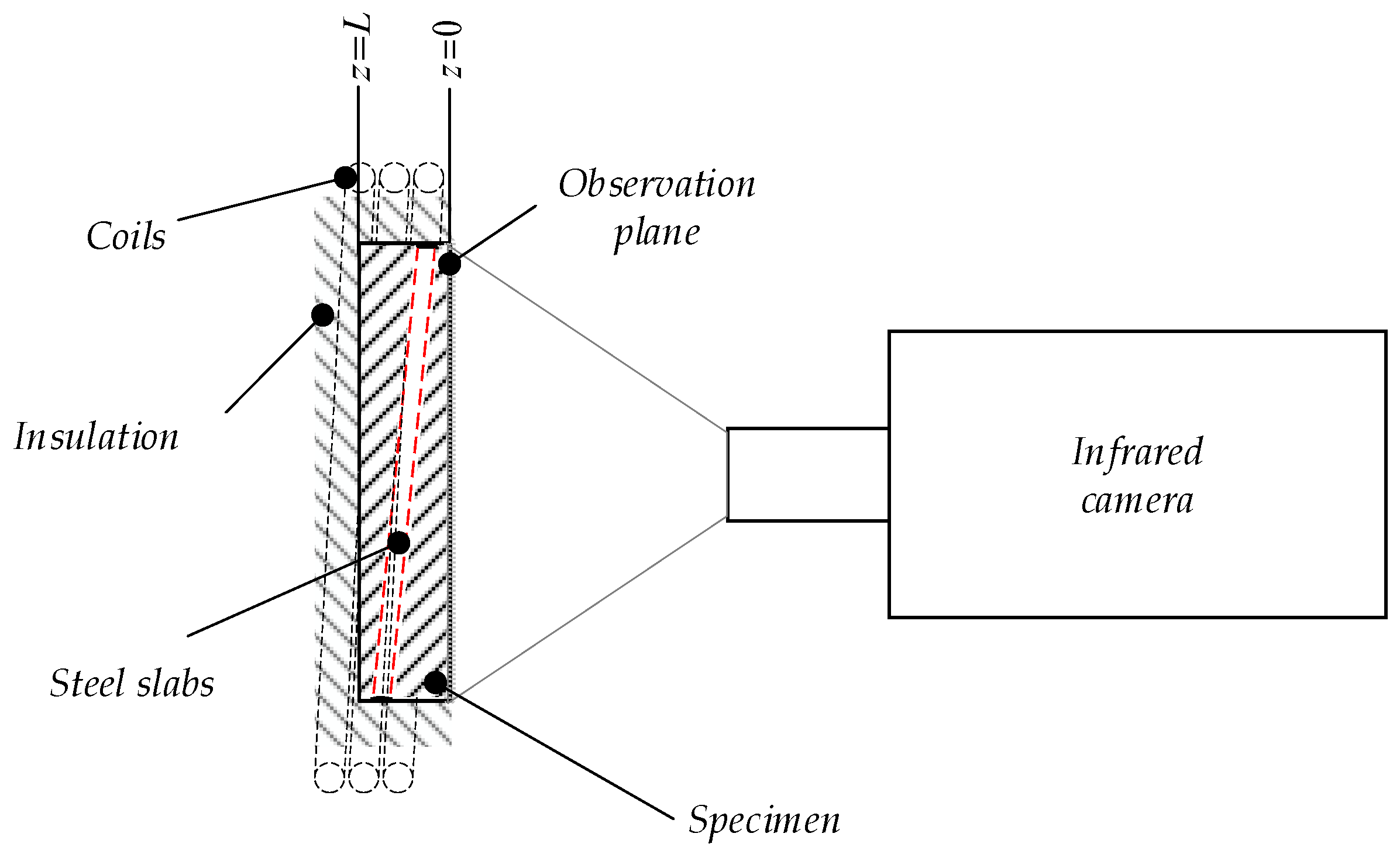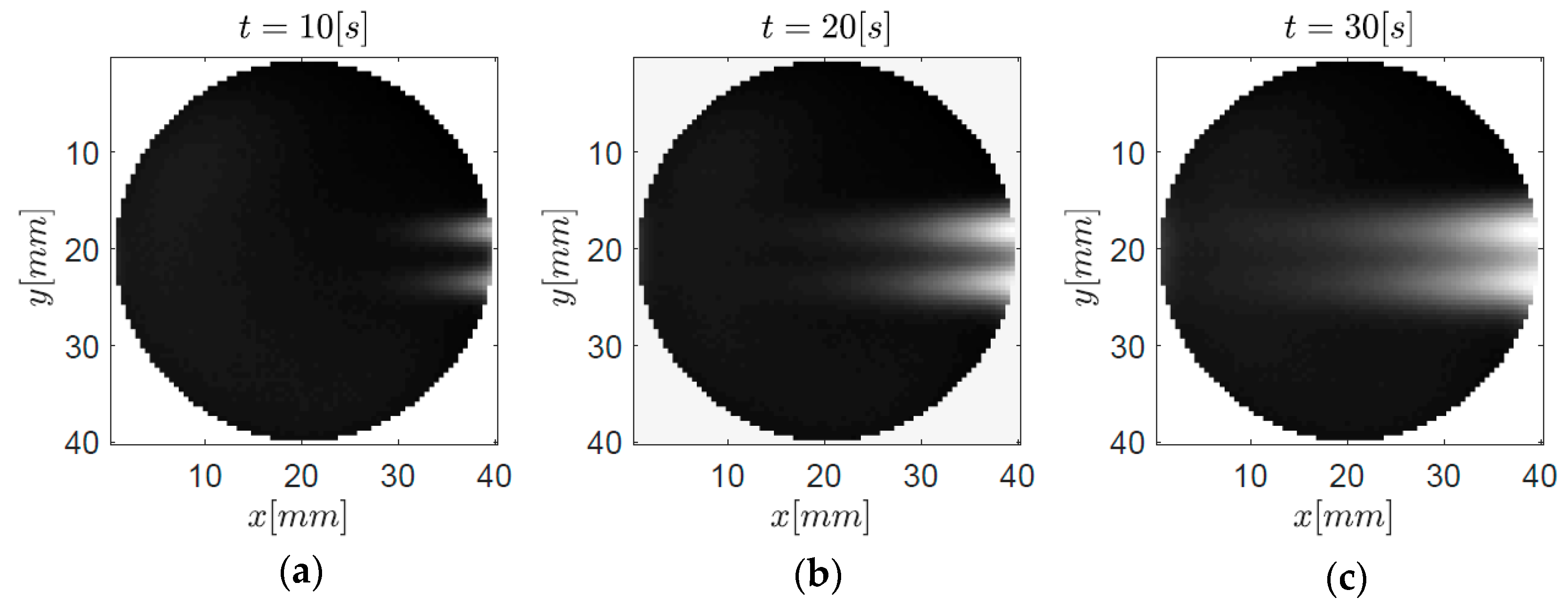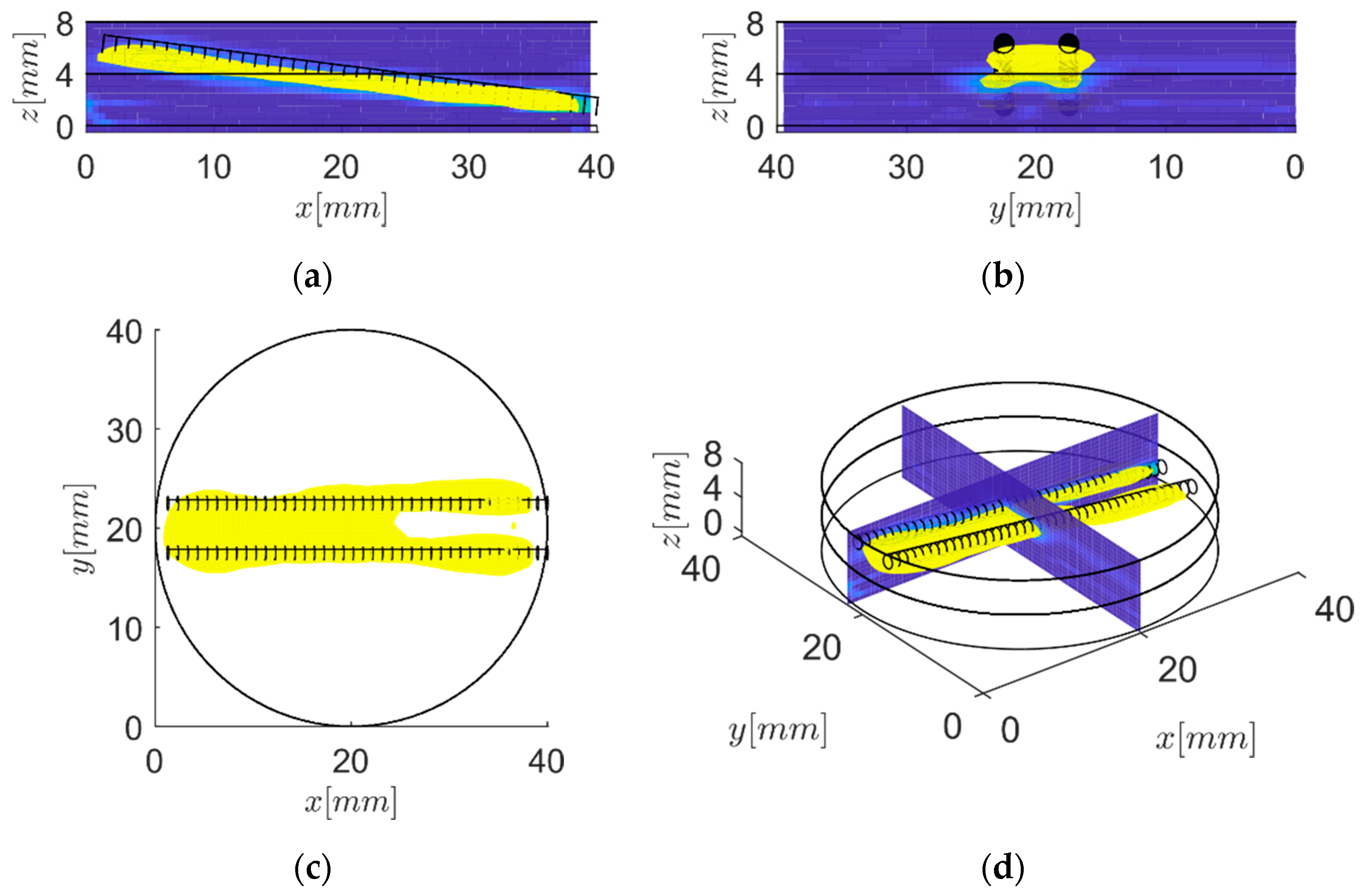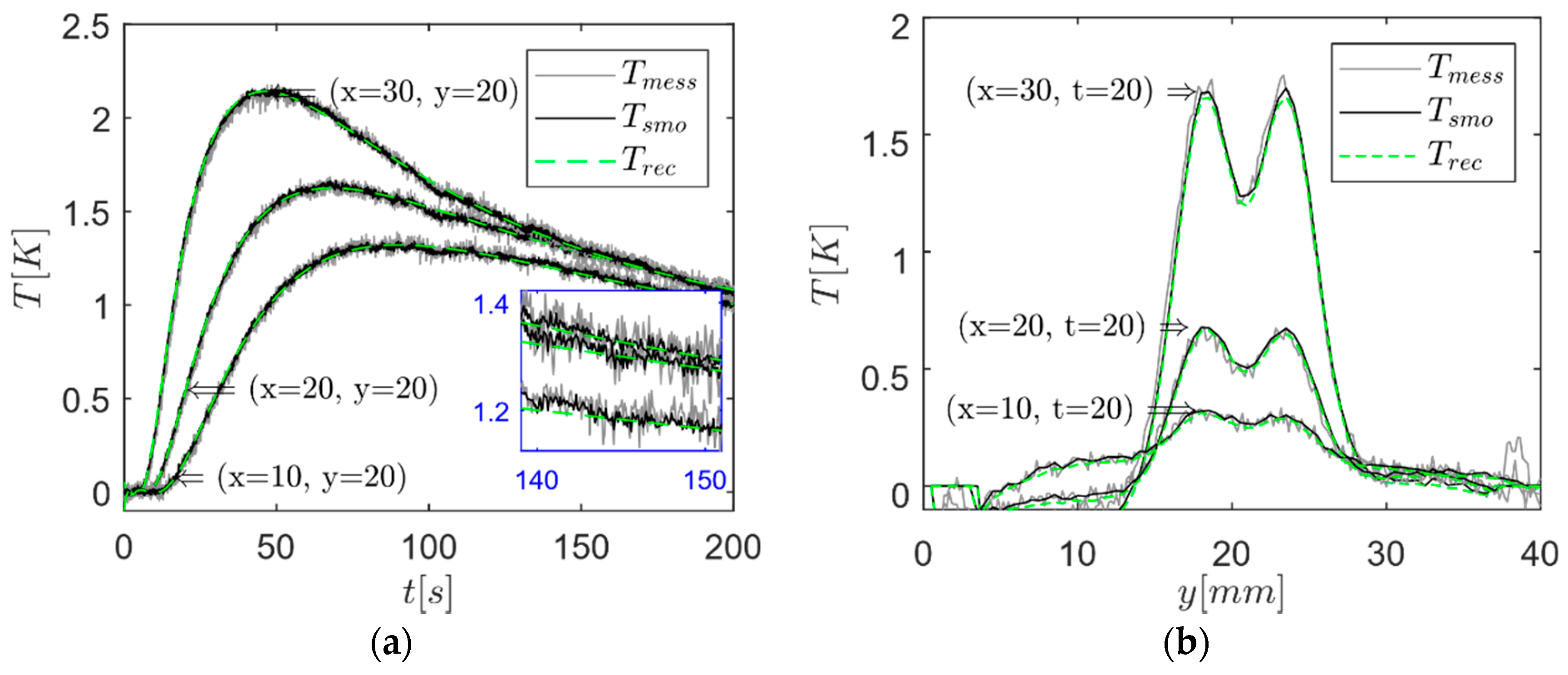2.1. Entropy Production, Information Loss and Spatial Resolution
As already mentioned in the introduction, Equation (5) is a local transformation. For the same sample location
r, it is a transformation between the virtual wave
Tvirt(
r,t), which is a reversible solution to the wave Equation (2), and the temperature
T(
r,t), which is an irreversible solution of the diffusion Equation (1). Therefore, the calculation of
T(
r,t) from
Tvirt(
r,t) using Equation (5), which can be written for a discretized time as a matrix multiplication [
1] discards information. The matrix for kernel
K is not directly invertible, which is the mathematical consequence of the loss of information through entropy production during the heat diffusion process. Regularization methods such as the truncated singular value decomposition (T-SVD) method can be used to determine the (pseudo-) inverse matrix of the discrete kernel
K [
1]. The inverse problem, that the calculation of
Tvirt(
r,t) from
T(
r,t) is ill-posed, or the rank of the discretized kernel matrix is less than its size, because of the lost information. Poor discretization, low-quality infrared cameras or noisy amplifiers can increase the loss of information. However, even if all of these “technical” limitations can be neglected, the lost information equal to entropy production of heat diffusion cannot be recovered by any mathematical reconstruction algorithm and results in a loss of spatial resolution.
Thermodynamic fluctuations are the reason for the entropy production, which reduces the available information about the subsurface structures in the measured surface data. They are extremely small for macroscopic samples but are highly amplified due to the ill-posed problem of image reconstruction. For macroscopic samples, the resolution limit depends only on the amplitude of these fluctuations. The thermodynamic fluctuations and the entropy production caused by heat diffusion are strongly connected by the fluctuation-dissipation theorem. They are the “two sides of the same coin” of heat diffusion. Therefore, the truncation index for the regularization of the inverse problem using the T-SVD method is closely connected to the fluctuations, expressed by the signal-to-noise ratio (SNR). If the singular value of the kernel K is ordered in a monotonically decreasing order, the last singular value which is not set to zero (with the index equal to the truncation index) divided by the first singular value should be equal to the SNR (up to rounding errors).
In optics, it has been known since 2007 that optical diffusion in a strongly scattering sample can be “inverted” by wave front shaping [
4]. Coherent photons from a laser scatter in a deterministic way (at least for a certain correlation time), which is measured in a pointwise way. The resultant scattering matrix is used to change the light wave front, e.g., by a spatial light modulator in such a way that after the diffusive scattering the light is focused. For heat diffusion, phonons are not coherent and the propagation of phonons is highly uncorrelated in time. Therefore, a “phonon scattering matrix” cannot be measured and used to invert heat diffusion in time.
Non-equilibrium thermodynamics has made enormous progress the last decade. Heating light absorbing structures with a laser pulse and observing the temperature diffusion is definitely a process where the system state is far from equilibrium. One comprehensive letter about non-equilibrium thermodynamics, the second law and the connection between entropy production and information loss, was published in 2011 by Esposito and van den Broeck [
5]. They showed that for two different non-equilibrium states evolving to the same equilibrium state the entropy production Δ
iS during the evolution from one state to the other is equal to the information loss ΔI = k
BΔD, where k
B is the Boltzmann constant and ΔD is the difference of the Kullback-Leibler divergence D, also called relative entropy of these states. D is a measure of how “far” a certain state is away from equilibrium [
6]. The entropy production for the macroscopic states with small fluctuations around equilibrium turns out to be, in a good approximation, equal to the dissipated energy ΔQ, which is the heat transported by heat diffusion divided by the mean temperature T
mean, so Δ
iS = ΔQ/T
mean = k
BΔD [
7].
In Fourier-space, the information loss with increasing time can be described by a cut-off wavenumber,
kcut [
7]. Spatial Fourier transformation of the heat diffusion Equation (1) shows that after some time,
t, the heat diffusion reduces each Fourier component by a factor of exp(−
k2αt). Therefore, after a long time only the component with a wavenumber
k = 0 is different from zero, which shows that in the thermal equilibrium, the temperature is the same everywhere in the sample. The information content, which is the negative entropy, of each Fourier component is ΔS
k = 0.5k
B ×
SNR2 exp(−2
k2αt), with the signal-to-noise ratio
SNR. Now the cut-off wavenumber,
kcut, is defined in such a way that the information content in this Fourier component is so low that its distribution cannot be distinguished from the equilibrium distribution within a certain statistical error level (Chernoff-Stein Lemma [
6]). This error level can be set such that for wave numbers higher than
kcut the Fourier components are dampened below the noise level, which gives:
This is a principle thermodynamic limit for how good the initial temperature distribution can be reconstructed after some time. No mathematical regularization method can reconstruct information which has been discarded by the heat diffusion process.
In thermography, usually a temperature distribution is not measured at a certain time and the original temperature distribution
T0(
r) has to be reconstructed; but at certain locations at the sample surface, the temperature evolution for a certain time was measured and from that,
T0(
r) was reconstructed. For this case, we have shown that the spatial resolution limit is proportional to the depth and inversely proportional to the signal to noise ratio [
8].
2.2. Experimental Set Up
For the experimental investigations, two cylindrical steel rods were embedded into epoxy resin, as shown in
Figure 1. The embedded cylindrical steel rods had a diameter of 1.5 mm. The distance between the two steel rods along their cylindrical axis was 5 mm. The minimum distance between steel rods and the specimen surface was 0.75 mm in the
z-direction. The embedding material had radii of 20 mm and a thickness of L = 8 mm. The sample was not excited optically by a laser pulse but by induction of eddy current. For other samples such as a graphite slab embedded into an optically scattering epoxy matrix, we have shown that laser and eddy current excitation produced similar results. Here, using eddy current, a more homogeneous heating on a larger volume was possible. We used the induction generator HÜTTINGER 2, 5/300 (TRUMPF Hüttinger, Freiburg, Germany) with a power of 3 kW at a frequency of 200 kHz. The heating time was
th = 2 s, applying the maximum power of the generator.
The specimen was positioned in the center of the inductor coils, which had a diameter of 80 mm. The specimen was thermally isolated at the lateral area and at the rear side to minimize heat losses due to convection and radiation. Hence it can be postulated that for each surface adiabatic boundary conditions apply, as illustrated in
Figure 2. The temporal temperature distribution, at the front side of the specimen, was measured using an infrared camera that is sensitive in the spectral range of 3 to 5.1 mm. The infrared camera had a cooled indium antimonide InSb quantum detector with a focal plane array FPA of 1280 × 1024 pixels. The noise equivalent temperature difference (NETD) of the camera was 25 mK.
In
Figure 3, the principal sketch of the measurement set up is depicted. The spatial resolution of the infrared camera was 167 µm and the measurement time was 200 s with a frame rate of 12.5 Hz. According to the applied discretization, the virtual speed of sound was
c = 6.3 × 10
−3 m/s. Due to the opacity of the epoxy resin in the medium infrared regime, the surface temperature of the specimen was measured and not the surface temperature of the steel rods. To increase the
SNR, the mean value of nine adjacent pixels was taken, whereby the spatial resolution (
Δx,
Δy) was degenerated to 0.5 mm. The measured temperature distribution at the front surface of the sample is illustrated in
Figure 4 for different cooling times
t ((a) 10s, (b) 20s, and (c) 30s).
With increasing cooling time, it becomes very difficult to distinguish the embedded cylinders due to the decreasing resolution with increasing depth. Based on these temperature data, the virtual wave concept was applied to reconstruct the location and the initial temperature distribution
T0(
r) of the embedded cylindrical steel rods. Therefore, the virtual temperature field must be calculated from the measured temperature field and hence some kind of regularization must be introduced as stated above. To calculate the discrete kernel, the physical parameters in
Table 1 were utilized. To compute the pseudo-inverse of the kernel, the T-SVD was used.

